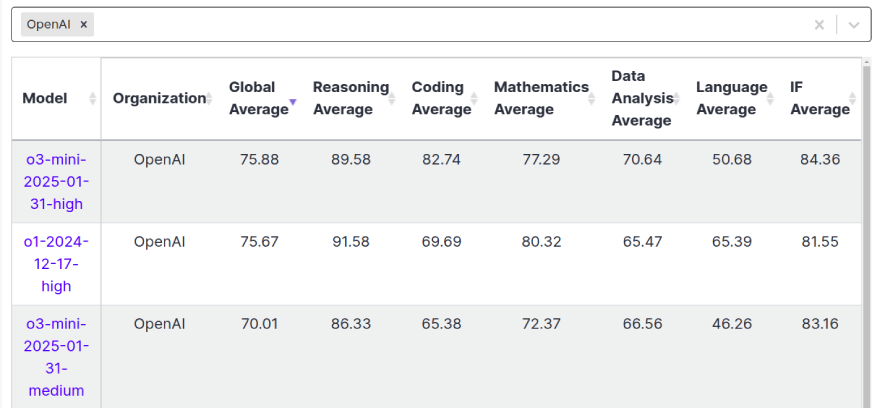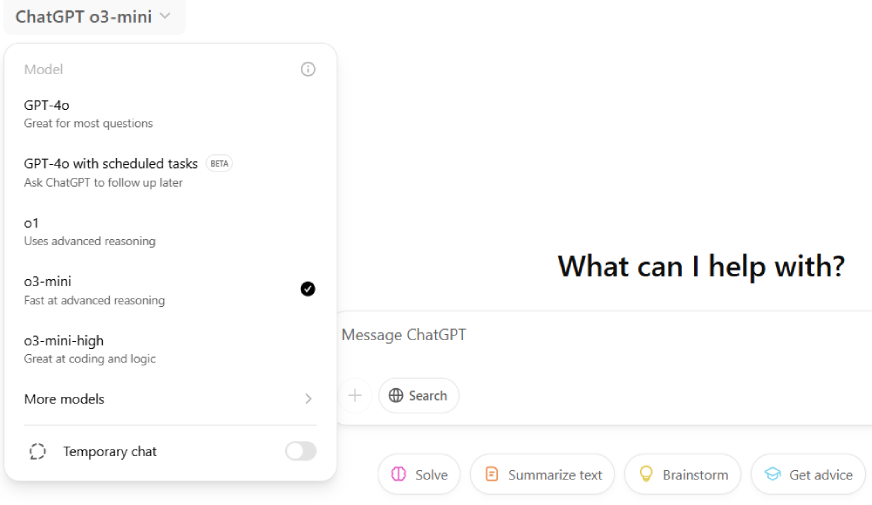
Today, OpenAI announced o3-mini’s new image analysis capabilities and unveiled its roadmap for GPT-4.5 and GPT-5. While the hype is high for the upcoming GPT models, this article is going to focus on o3-mini’s new image analysis feature, comparing it with o1. We will first do an o3-mini vs o1 comparison based on their performances on standard benchmarks. And then we will test both the models across multiple image-based tasks like spotting image differences, solving mathematical equations from visuals, and interpreting complex diagrams. By the end, we’ll find out which model delivers superior image analysis and at what tasks each one performs best.
o1 vs. o3-mini: Benchmark Performance
o3-mini and o1 are two of OpenAI’s best-performing models for complex reasoning and problem-solving tasks, each with distinct strengths. Before we begin with the comparison, let’s look at the architecture of both the models and understand how they think.
o3-mini follows a dense transformer architecture, utilizing all parameters per token to maximize accuracy, making it highly effective but computationally demanding. In contrast, o1, optimized for logical reasoning and mathematical tasks, balances efficiency and performance with a structured processing approach. This difference plays a crucial role in their benchmark results, influencing their respective strengths across various domains.
Also Read: Can o3-mini Replace DeepSeek-R1 for Logical Reasoning?
Now, here’s how the two models performed in the LiveBench set of tests.

Sources: livebench.ai
As you can see, the benchmark evaluations show o3-mini (high) being in close competition with o1 (high) with global averages of 75.88 and 75.67, respectively. That being said, o3-mini excels in coding and data analysis, making it ideal for structured programming and analytics. Meanwhile, o1 dominates in reasoning and math, proving to be superior in numerical problem-solving. Additionally, o1’s language score highlights its strength in linguistically complex tasks. While o3-mini offers a balanced skill set, o1’s superior logic and language capabilities make it a compelling choice for technical applications requiring deep analytical reasoning.
Also Read: Is OpenAI’s o3-mini Better Than DeepSeek-R1?
How to Access o1 and o3-mini?
The o1 and o3-mini models are available to ChatGPT Plus and ChatGPT Pro users. While the ChatGPT Pro plan allows unlimited chats, the Plus plan only allows a limited number of chats with the models. The free version of ChatGPT uses o3-mini at the back for a limited number of reasoning queries per day. To access the models:
- Head to ChatGPT and login to your Pro/Plus account.
- At the top, on the left-hand side of the screen, under the model choice, you can select the model that you wish to work with.

Also Read: How to Run OpenAI’s o3-mini on Google Colab?
o1 vs o3-mini: Image Analysis Comparison
With o1 and o3-mini both making waves in the field of AI, the debate over which model reigns supreme is heating up. While o3-mini is OpenAI’s most advanced reasoning model, optimized for structured problem-solving and programming, o1 has emerged as a powerhouse in logical deduction, mathematical reasoning, and language comprehension.
To settle the score, we’re putting both models to the test with five rigorous challenges:
- Finding the differences between two images
- Predicting chess moves
- Solving a mathematical equation
- Identifying and explaining a scientific diagram
- Interpreting and analyzing a graph
Challenge 1: Image Analysis with Object Identification
Prompt: “In the given image Identify all the differences between them and describe them in short.“

Response by o1

Response by o3-mini

Comparative Analysis
o3-mini provides a more detailed and nuanced analysis of the image differences compared to o1. While o1 correctly identifies major distinctions, o3-mini goes a step further by capturing subtle variations like the bear’s smile and the exact placement of bees. This demonstrates o3-mini’s superior observational precision and attention to fine details, making it a stronger choice for tasks requiring visual reasoning and meticulous analysis.
Challenge 2: Image Analysis with Logical Reasoning
Prompt: “Analyze this chessboard position. Suggest the best move for the current player (white) to checkmate black and explain the reasoning.”

Response by o1

Response by o3-mini

Comparative Analysis
Both o3 and o1 provided incorrect answers when I compared their responses based on the chess-related prompt. I was testing these models to see how accurately they handle tasks related to chess, but unfortunately, both of them failed to deliver the correct solution. Despite their capabilities, the outputs did not align with the expectations for a problem that requires reasoning and knowledge of chess rules.
Challenge 3: Image Analysis with Mathematical Reasoning
Prompt: “Solve the mathematical equation in the image“

Response by o1



Response by o3-mini



Comparative Analysis
Both o3-mini and o1 correctly identify the roots of the polynomial P(x) = x^3 + 2x^2 – 5x – 6 using the Rational Root Theorem, synthetic division, and factoring. However, o3-mini presents the solution in a structured in a step-by-step manner with clear formatting, making it more readable. o1, on the other hand, provides a very similar explanation but appears slightly less structured, with some redundancy in the explanation. Both responses arrive at the correct final answer: the roots x=−1,2,−3 but o3-mini presents a clearer and slightly more refined approach.
Challenge 4: Image Analysis with Scientific Explanation
Prompt: “Identify the experiment shown in the image. Explain what is happening and what are the outcomes of the experiment.“

Response by o1


Response by o3-mini


Comparative Analysis
Both o3-mini and o1 provide accurate explanations of the Miller-Urey Experiment, detailing its purpose, methodology, and significance. However, the o3-mini presents the information in a more structured, well-organized manner with clear headings and bullet points, making it easier to follow. It explicitly emphasizes the continuous cycling of gases and highlights the significance of the experiment in astrobiology. On the other hand, o1 adds extra details, such as the sampling probe and heat source, which provide additional context but may not be as necessary for a general explanation. While both responses are correct, o3-mini offers a more polished and reader-friendly presentation, whereas o1 provides a slightly more detailed breakdown of the experiment’s setup.
Challenge 5: Image Analysis with Data Interpretation
Prompt: “The bar graph given below shows the sales of books (in thousand number) from six branches of a publishing company during two consecutive years 2000 and 2001.
Sales of Books (in thousand numbers) from Six Branches – B1, B2, B3, B4, B5 and B6 of a publishing Company in 2000 and 2001.
What is the ratio of the total sales of branch B2 for both years to the total sales of branch B4 for both years?
A. 2:3
B. 3:5
C. 4:5
D. 7:9”

Response by o1


Response by o3-mini


Comparative Analysis
Both o3-mini and o1 provide correct answers for calculating the ratio of total sales for branches B2 and B4, arriving at the correct answer of 7:9 (option D). However, the o3-mini presents a more structured and reader-friendly approach, breaking the solution into clear steps: extracting sales data, computing the ratio, simplifying, and identifying the correct answer. This logical flow improves readability and comprehension. In contrast, o1 follows the same steps but has formatting inconsistencies, particularly in fraction representation, making it slightly harder to follow. While both responses are accurate, o3-mini delivers a more polished and well-organized explanation, whereas o1 provides the same logic with minor formatting issues.
Comparative Analysis Summary
| Challenge | o3-mini | o1 | Verdict |
| 1. Find the Difference Between the Images | Identified subtle differences, demonstrated superior visual reasoning | Identified major distinctions but missed finer details | o3-mini Wins |
| 2. Find the Checkmate Position | Incorrect answer failed to apply chess reasoning accurately | Incorrect answer also failed to apply chess reasoning accurately | Both Failed |
| 3. Solve the Mathematical Equation in the Image | Correct solution, structured step-by-step explanation, clear formatting | Correct solution, similar explanation but less structured and slightly redundant | o3-mini Wins |
| 4. Identifying the Miller-Urey Experiment | Well-organized, structured explanation with clear headings and bullet points | More detailed explanation but less structured | o3-mini Wins |
| 5. Data Interpretation (Sales Ratio Calculation) | Correct answer, structured and reader-friendly explanation | Correct answer, but formatting inconsistencies | o3-mini Wins |
Also Read: Is Google Gemini 2.0 Pro Experimental Better Than OpenAI o3-mini?
Conclusion
In this o3-mini vs o1 comparison, we have seen that o3-mini gives better responses than o1 in most instances. It demonstrates strong reasoning abilities, structured explanations, and attention to detail, making it a standout performer in many tasks. Moreover, its ability to break down complex problems into well-structured steps enhances readability and comprehension.
While o1 is also a capable model, it occasionally struggles with formatting inconsistencies and gives slightly less structured responses. However, it still provides accurate reasoning and solid logical flow.
Neither model is flawless—both had difficulties with chess-based reasoning and while o3-mini tends to present more polished responses, o1 sometimes offers additional contextual details. Despite their limitations, both models prove to be valuable tools for enhancing productivity in problem-solving, analysis, and interpretation tasks.
Frequently Asked Questions
A. o3-mini has better observational precision, capturing subtle differences in images, while o1 correctly identifies major distinctions but lacks the same level of fine detail.
A. Both models correctly solve mathematical equations, but o3-mini presents solutions in a more structured and step-by-step manner, improving readability.
A. Yes, both models failed to correctly determine the checkmate position in chess, highlighting a weakness in chess-based reasoning and strategy understanding.
A. o3-mini offers well-structured, concise explanations with bullet points and clear emphasis on key aspects, while o1 sometimes includes extra contextual details that may or may not be necessary.
A. o3-mini demonstrates strong logical reasoning and step-by-step breakdowns, whereas o1 also performs well but may have slight formatting inconsistencies in its explanations.







